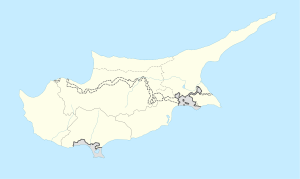Potamia, Cyprus
| Potamia | |
|---|---|
| Ποταμιά (Greek) Potamya (Turkish) | |
| Location in Cyprus | |
| Coordinates: 35°2′31″N 33°26′42″E / 35.04194°N 33.44500°ECoordinates: 35°2′31″N 33°26′42″E / 35.04194°N 33.44500°E | |
| Country |
|
| District | Nicosia District |
| Population (2001) | |
| • Total | 415 |
| Time zone | EET (UTC+2) |
| • Summer (DST) | EEST (UTC+3) |
Potamia (Greek: Ποταμιά, Turkish: Potamya, Bodamya and Dereliköy) is a village in the north-east of government controlled Cyprus in the district of Nicosia, close to the Green Line separating it from the area of Northern Cyprus. Together with Pyla and Rizokarpaso, Potamia forms one of the few remaining ethnically mixed communities in Cyprus, made up of Greek and Turkish Cypriots.
Here lie the remains of the Royal Residence of King Peter II (1369-1382), destroyed by the Saracens in 1426. When the site was visited by Rupert Gunnis in 1936, only a portion of the walls, a large vaulted room with fragments of frescoes, remained.
Prior to the inter-communal conflict and the Turkish invasion of Cyprus of 1974 the village had a Turkish-Cypriot majority, however most Turkish Cypriots have subsequently emigrated to Northern Cyprus, and now the village is mostly inhabited by the remaining Greek-Cypriots. Nonetheless, the village has a history of co-existence between the two communities, and Greek and Turkish Cypriots still live side by side. Recently there has been some lobbying to convince Turkish Cypriots to return, and some have done so.
There is widespread bilingualism and cooperation between the two communities, and the village has both a Greek and a Turkish-Cypriot mayor who work together. In line with the bi-communal character of the village, it is the home of Radio Potamia, an FM radio station that broadcasts equally in Greek and Turkish. These broadcasts reach both northern and southern Cyprus, with the stated aim of promoting mutual understanding and respect between the communities.
...
Wikipedia

